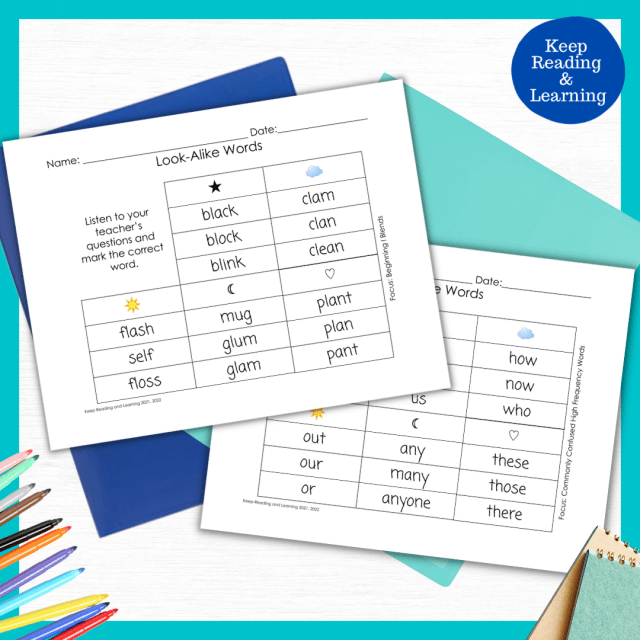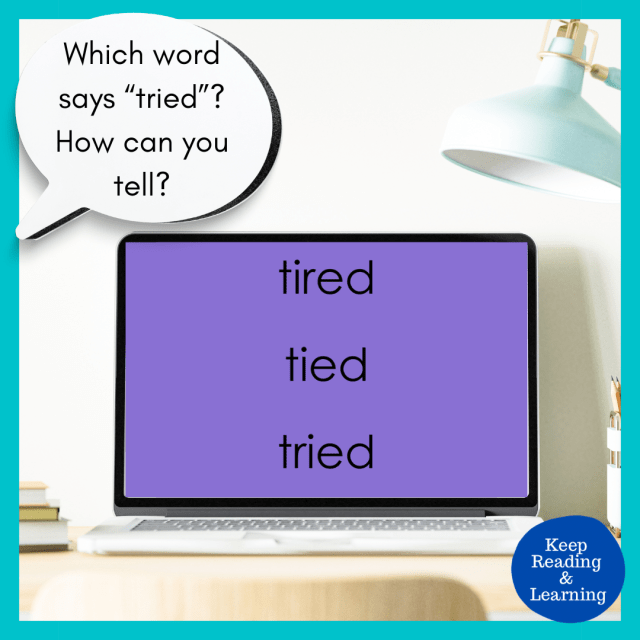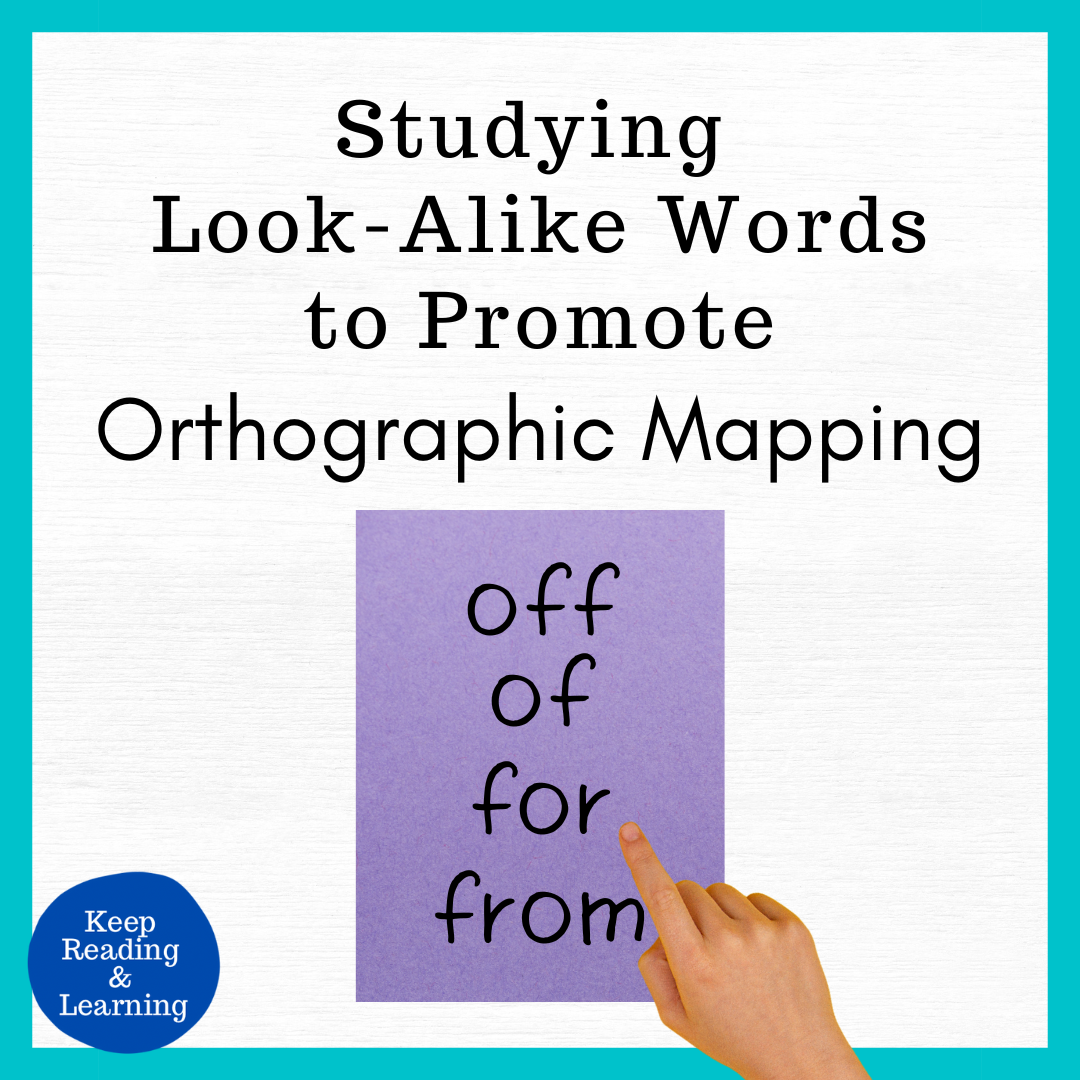Do you have students who make guesses based on initial letter sounds instead of sounding out words? It’s time to teach good habits! Using look-alike words will help your students develop the habits required to gain sight words, which means that they will recognize more words with automaticity instead of making guesses. If your students tend to guess at words, this post is for you! Get ready to take some notes.

This post contains affiliate links.
Why do our students develop the guessing habit?
If we push children to read before they develop the pre-requisite letter/sound and phonemic awareness skills necessary for effective orthographic mapping, then we run the risk of nudging these students to develop ineffective habits (Kilpatrick, 2016). Read my previous post about these students here.

Think about it: if a child is trying to decode the word knight but they:
- haven’t yet learned the letter pattern igh
- haven’t yet learned about silent letter patterns like kn
- haven’t fully developed their understanding of the alphabetic principle (the concept that letters and letter strings represent sounds)
- are not yet skilled at blending phonemes into words
Then, how do we expect this child to figure out the word? Instead of making connections between the letters and sounds, this child will likely look at the picture, use context clues, make a guess, or even just skip the word completely. These strategies can impact the child’s comprehension of the text. These are the strategies of poor readers.
Often, these students have memorized many words by sight without becoming aware of the letter-sound connections. They might know the word see when they encounter it, but they don’t realize that ee represents the /ē/ sound, for example.
At first, this might not sound like a bad thing because knowing words quickly is great. However, the brain has a finite capacity for words memorized by sight with visual memory (Kilpatrick, 2016). Additionally, if this child made letter/sound connections in the word see, they would be better prepared to decode words like bee, tee, and seen.
This is why many students “hit a wall” around the end of second grade or beginning of third grade: they can’t possibly memorize any more words by sight but they never developed effective strategies for decoding unknown words. These readers will struggle as text becomes increasingly more complex.
How can look-alike words help students develop more effective habits?
First, make sure the basics are covered: Students need direct, explicit instruction in phonics. They need to practice blending and segmenting sounds to read and spell. They need to learn to connect letters with sounds in both regularly-spelled and irregularly-spelled words. Students will also benefit from morphology instruction, which begins with simple concepts like suffixes -s and -es.
A great way to boost the development of good habits is with teacher-directed look-alike word activities. Kilpatrick (2016) believes that working with look-alike words “may be one of the most powerful tools in your ‘bag of tricks.'”

Studying words that appear similar will train your students to carefully analyze words instead of using the compensatory strategies mentioned above. Students will begin to make connections between each sound within a word and the letter(s) that represent the sounds. These habits are essential to the process of orthographic mapping, which is what helps students retain words in long-term memory for efficient retrieval. That’s a fancy way of saying that words become known by sight (Kilpatrick, 2016).
The goal of studying look-alike words is not to memorize the words presented during the activity but to develop the habit of word analysis. Daily practice will help develop and then reinforce new skills.
What age or grade are look-alike word activities for?
Students in any grade or age group will benefit! This strategy can be used with your earliest readers to teach them effective strategies from the beginning. It can also be used with older readers who need to reverse their reliance on compensatory strategies.
How can I implement look-alike word activities with my students?
You can combine the direct mapping technique with look-alike word study. Direct mapping is a technique used to help students make connections between the individual sounds within words and the corresponding letters (Kilpatrick, 2016). The teacher asks questions that will help students develop essential skills for successful word recognition. Through the direct mapping process, students will:
- practice segmenting and isolating phonemes
- develop the habit of studying the entire word instead of looking at the first letter and making a guess
- learn to rely on the regular letter-sound connections to decode, which takes the mystery out of many high-frequency words, particularly ones with irregular elements
- be encouraged to orthographically map letter strings. The letter strings may include portions of a word (e.g. the am word family) or the whole word.
Once words have been mapped, they are in long-term memory for automatic retrieval. Remember: That’s a fancy way of saying words become sight words!
Ready? Let’s combine look-alike words with direct mapping!
I’ll walk you through an example that uses my resource, but you could simply write three similar or often-confused words on the whiteboard. In my resource, icons are used to make it easy for your youngest readers to locate the list.
Direct your students’ attention to a word list: “Let’s look at the cloud list.”

Ask questions that require the students to analyze the letter-sound connections in the words. “Which word says it? How can you tell?” The first few times you complete the activity, you can model appropriate responses. “I can tell the second word says it because it ends with the /t/ sound.” You can get as detailed as you want! If you’re working on closed syllables, you can encourage your students to notice that each word has an i closed in by a consonant, so they all start with the short i sound. You can also have a conversation about the letter s representing the /z/ sound in is.

Here’s an example with more challenging words. “Let’s look at the cloud list. Which word says house? How can you tell?” Responses you can model include: “I can tell that the first word says house because I see ou in the middle and that says /ou/. I know it’s not the second word because that has an m and there’s no /m/ in the word house. I see /or/ in the third word so that cannot be house.”
The questions you ask and the conversations that follow are what will prompt your students to develop the good habit of using each letter/sound connection to determine the word.
A note about being a careful consumer of similar activities
Some other look-alike word activities are completed by sorting the words by appearance without ever reading them! This makes it a visual task and ignores the fact that we acquire new words through orthographic mapping. If an activity simply asks students to color each word or sort them into lists, ask yourself if the student could complete the activity without reading.
Other look-alike word activities include picture clues that still allow the possibility of guessing based on sounds. These types of resources can be completed independently and may be helpful once you’ve directly taught the habits that were discussed above. Although I can see the benefit of asking some students to complete look-alike activities independent of teacher support, I feel strongly that look-alike word activities are best completed with the guidance of a teacher to ensure that students are developing the skills we want them to develop. When you complete teacher-directed look-alike activities, your conversations with students will also give you valuable insight into their current skill set for identifying unfamiliar words.
The good news is that daily look-alike word practice can be implemented quickly in a variety of settings, and I think you’ll find it well worth your time to spend a couple of minutes a day leading a look-alike word activity!
How can I use the look-alike word strategy on a budget?
Choose three words and display them for your students. Use the direct mapping technique, explained above. That’s it!
Wondering where to get your words from? You have two main options. First, you can choose words that align with your current phonics concept. Working on initial consonant blends? Here are some word lists you can use:
- black, block, brick
- trip, grip, trap
- spin, snip, snap

Another option is to use commonly-confused high-frequency words. Maybe you noticed that your students have difficulty differentiating between for, from, and of. Post these words on the board and use the direct mapping technique.
Although of is irregularly spelled, I find that it helps to point out that it starts with a vowel sound, which is expected since it starts with a written vowel. I also ask questions that lead students to notice that from starts with the blend /fr/, while for starts with the /f/ sound. After quick, daily direct mapping sessions with these three words, my students have committed them to memory within days.
Do you want look-alike word lists that have already been made for you?
My look-alike word activities, which are completed with your guidance, will encourage your students to analyze, segment, blend, and actually read each word. You’ll receive 240 lists of look-alike words for word study, available as printable worksheets or a digital version for Google Slides™.

Each worksheet page includes five lists within the given skill, which makes it easy to commit to daily practice: You can use the same worksheet all week and do one list per day. Or maybe you didn’t have time on Tuesday so you doubled up on Wednesday. Using one sheet per week means that the lists are always there and ready for you to squeeze in five minutes of look-alike word practice. Some teachers have students keep the page in their reading binder so they can easily open to the look-alike word section when it’s time.
How can the look-alike word activities be used in my classroom?
The words are organized by complexity and cover all six syllable types. There are also several pages of commonly confused high-frequency words (e.g. though/thought/through). You can use any and all pages your students need! Because the words include all 6 syllable types, you’ll be able to use this resource again and again throughout the school year.

If you have a projector, consider purchasing the bundle, which includes a slide deck for Google Slides™️. The digital version uses the same words as the worksheet version. Your students can view the words on the board and follow along on their paper at the same time. For increased engagement, you can have the students mark the words with crayons, colored pencils, highlighters, etc. If you’re short on time, you can complete the activity orally and with pointing responses. Or maybe you just want the slide deck to use with the whole class and not have to worry about where to keep the worksheets for easy access– choose what works best for you!

Both the digital and worksheet version include a blank template for you to write in your own words if you’d like.



